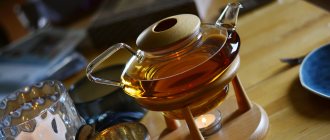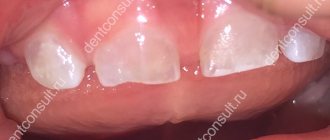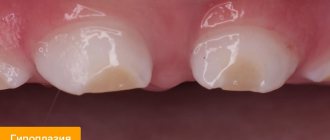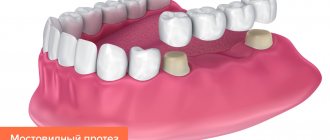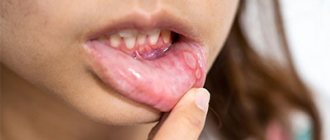Problem: “tetracycline teeth”
“Tetracycline teeth” is a characteristic of discoloration of enamel as a result of taking an antibiotic called tetracycline.
It is used to treat acute diseases caused by various bacteria. For example, pneumonia, acne, anthrax, cholera and so on. Moreover, tooth staining occurs regardless of whether the child himself took the drug, was in the mother’s stomach, or was fed breast milk. The active substances are deposited not only in the dental tissues, but also in the bone structure of the child. The most dangerous thing is that not only the outer enamel of the teeth is stained, but also the inner layer - this explains the difficulty of restoring the whiteness of the dentition.
Not the entire tooth may become stained, but only part of it, depending on which part of the tooth was formed when taking the antibiotic.
YELLOW TEETH. WHY DOES TEETH ENAMEL YELLOW?
YELLOW TEETH. WHY DOES TEETH ENAMEL YELLOW?
We all want our smile to look perfect, and the whiteness of the teeth enamel plays an important role in this. Yellow teeth look sloppy and create an unpleasant impression on the interlocutor, as a person who neglects personal hygiene and does not take care of himself. Tooth enamel is the hard tissue that covers the crown of the tooth. Has protective and aesthetic functions. Enamel care is one of the most important stages of daily hygiene. It is true that enamel is never snow-white from birth; by nature it has a yellowish tint. However, it is necessary to distinguish natural yellowness from acquired yellowness. In the first case, the surface of the enamel will be slightly yellow, but smooth, without plaque, while the most saturated part of the color falls on the gingival part of the tooth, while there is practically no color at the edge. In the case of pathological yellowing and discoloration due to improper oral hygiene, yellowness covers the entire surface of the tooth. There are many reasons for yellowing of enamel. REASONS FOR YELLOWING ENAMEL 1. Naturally yellow teeth are determined by genetic inheritance from parents, and not by the health of the body. 2. Bad habits: smoking, uncontrolled consumption of strong caffeine-containing drinks such as coffee and tea. A smile with yellow teeth is the calling card of a heavy smoker. At first, a soft, pale yellow plaque forms on the teeth, then, over time, it darkens and hardens, literally sticking to the enamel. Yellow teeth from smoking and coffee can be easily whitened, since the staining rarely penetrates into the deep layers of enamel and it is enough to remove plaque. In addition, tea, especially black tea, can also turn teeth yellow. For hookah smokers, plaque appears even faster, because in the cigarette some of the tar remains in the filter, which the hookah simply does not have. 3. Taking medications and antibiotics often leads to weakened and yellowed teeth. Tetracycline stains enamel especially strongly when taken for a long time. 4. Consumption of sugar, as well as sugar-containing dishes, desserts and drinks, inevitably leads to yellowing of the enamel layer. 5. Food dyes, which are now contained in almost all products, constantly penetrate microcracks in the enamel, leading to a change in its color. The reason for this phenomenon may be the frequent consumption of wine, multi-colored carbonated drinks, even beets and carrots, coffee, black tea. Of course, this does not mean that such products should be urgently abandoned, but it is still worth controlling the amount of their consumption. 6. Diets can also be one of the possible causes of enamel staining, especially if these diets alternately and uncontrollably replace one another. With such constant stress on the body, the reaction of the teeth to the lack of nutrients, minerals and vitamins is quite natural and predictable. 7. Age-related changes lead not only to a gradual deterioration in health, but also to partial destruction of tooth enamel and the formation of secondary dentin. It is for this reason that the yellowest teeth are usually found in older people. 8. Damage and trauma can cause irreparable damage to teeth. If, as a result of a blow to the jaw, an accident, a careless fall or other troubles, your tooth has turned yellow, there is a possibility that the pulp area was damaged during the injury. At the same time, the tooth itself may not lose its vitality. 9. Braces are useful for correcting malocclusion, but their prolonged contact with the tooth and insufficiently thorough cleaning of food debris can ultimately lead to yellow spots appearing on the teeth in places of contact with the fasteners. 10. Insufficient oral hygiene leads to the formation of yellow plaque on the teeth. Skipping daily oral hygiene routines, replacing your toothbrush with chewing gum, using the wrong toothpaste, and much more. 11. Severe diseases (Addison's disease, diseased kidneys, blood diseases, fluorosis, hematogenous jaundice, problems with the adrenal glands). Yellow teeth from infection are not uncommon, and before whitening such yellowness, it is necessary to treat the root cause if possible. After all, if the disease remains and continues to destroy the enamel, then whitening will only worsen the situation by weakening the dental tissues. 12. Poisoning by heavy metal vapors is one of the most dangerous causes of discoloration of enamel. 13. Yellow teeth from water are characteristic of people living in areas remote from large cities, where the water entering the water supply system is oversaturated with minerals and iron. Most often, it does not undergo the necessary filtration and, if consumed for a long time in an unrefined form, leads to the formation of plaque.
Free consultation More about the clinic’s doctors
You can find out other details by calling clinic 8,
Expert opinion
Roman Borisovich Alekperov
orthopedic dentist
Experience: 24 years
Today there are various ways to solve the problem of tetracycline teeth. Starting from ceramic veneering to covering teeth with crowns. In any case, you can choose an option that suits your budget. Don’t waste time, get your teeth in order, and get rid of aesthetic problems and psychological discomfort that this dental pathology causes.
Professional whitening methods
The dental practice is equipped with the latest equipment, allowing for effective and gentle teeth whitening. Here are the most popular methods:
- Ultrasound teeth cleaning. This removes soft dental deposits. During the procedure, a special device with tips is used, which, in addition to plaque, also removes stones. Finally, the teeth are polished with protective pastes.
- Laser whitening. The tooth is coated with a special gel, then the specialist acts on it with a laser. Each tooth is processed for 1-2 minutes.
- Air Flow technology. Its essence lies in the fact that tooth enamel acquires natural whiteness due to exposure of the tooth surface to fine powder based on soda and silicon dioxide.
Separately, it is worth mentioning photo teeth whitening or the ZOOM whitening system. The method is based on coating the teeth with a special gel containing hydrogen peroxide. Under the influence of ultraviolet radiation, peroxide decomposes and coloring substances are removed from the enamel with the help of the resulting oxygen. Unlike other whitening procedures, photobleaching takes less time and allows you to change the shade of the enamel by several tones at once. That is why patients often choose this method.
During professional whitening, teeth remain intact and the results last for many years.
As you can see, yellow plaque on teeth is not a problem today. The main thing is to contact a specialist who can choose the optimal whitening method to effectively deal with the most difficult case. As a result, your teeth will be snow-white and the dream of a Hollywood smile will come true!
Solution
Option 1: Teeth whitening. If teeth have a slight and uniform discoloration, regular whitening will be effective. For example, using ZOOM 3 technology. As a result of a simple procedure, it is possible to change the color of teeth by 8-12 shades and achieve the preservation of the result for several years. In addition, whitening is quite safe for teeth and allows you to change the shade of enamel even on sensitive teeth. Read more>
Option 2: Prosthetics with veneers. However, in most cases, teeth whitening will not achieve 100% white enamel. In case of obvious staining of teeth, the only effective method of restoring a smile is microprosthetics with veneers. Veneers are thin overlays that are fixed to the front part of the tooth. They allow you to hide all visible imperfections - dark spots, chips and cracks, as well as gaps between teeth and even minor changes in the position of the teeth. Outwardly, they resemble dental lenses and serve to create ideal dental aesthetics. Veneers are created individually and the patient will be able to choose not only the shape, but also the color of future teeth. Read more>
How to get rid of yellow plaque on children's teeth?
The main thing is to determine why the child has yellow teeth. And, based on the causes of the problem, begin a comprehensive fight against it.
It is important to understand that even if baby teeth turn yellow, it means that something is wrong in the body. Yes, baby teeth will be replaced by permanent teeth. But the problem will remain and will only get worse over time.
What to do to cope with yellowing of teeth in a child 1-2 years old or older?
Watch your diet
First of all, you need to pay attention to the baby’s diet. Tea, sweets, carbonated drinks are the cause of early yellowing of teeth. Additionally, natural foods such as pumpkin can also stain enamel. It is important that the diet is balanced. It is important that the child eats not only soft, but also hard vegetables and fruits. This will not only cleanse your teeth of plaque, but also strengthen them.
Teach hygiene skills
It is necessary to teach your child how to properly brush his teeth on his own and monitor this process. Paste and brush, mouth rinses and other hygiene equipment should be appropriate for the baby’s age.
To maintain oral hygiene, it is recommended to use cleansing wipes, for example, Asepta Baby, made in the form of a fingertip. They gently cleanse teeth and gums of plaque and disinfect the oral cavity.
After the child has 5-6 teeth, you can start brushing them. It is important that parents themselves know how this process should proceed correctly. You can consult your dentist before starting.
It is also important to choose suitable hygiene products, for example, Asepta Baby toothpastes for children with a reduced amount of fluoride in the body and special toothbrushes for their first teeth. The cleaning process must be supervised by adults.
To quickly get rid of yellow teeth, dentists recommend using one of the following methods:
- Mechanical cleaning. It is suitable for cleaning permanent teeth and should be performed by a specialist. This procedure cannot be carried out frequently. In addition, it is contraindicated for those whose teeth have turned yellow due to the thinness of the enamel.
- Use of bleaching agents. They are either used in the form of ointments, or they are offered to rinse the mouth. The effect from them comes more slowly than from mechanical cleaning, but in general they are a more gentle method of whitening. Attention: whitening products have age restrictions! Consult a specialist before using them!
- Use of ultraviolet lamps. This method is especially effective if the teeth have turned yellow due to the use of antibiotics or an unhealthy diet with an abundance of sugar or food coloring.
- Coating teeth with special solutions. For example, silver or fluoride varnish. This will not only solve the problem of yellowness, but also protect the enamel from possible caries or other damage. Also recommended for permanent teeth.
